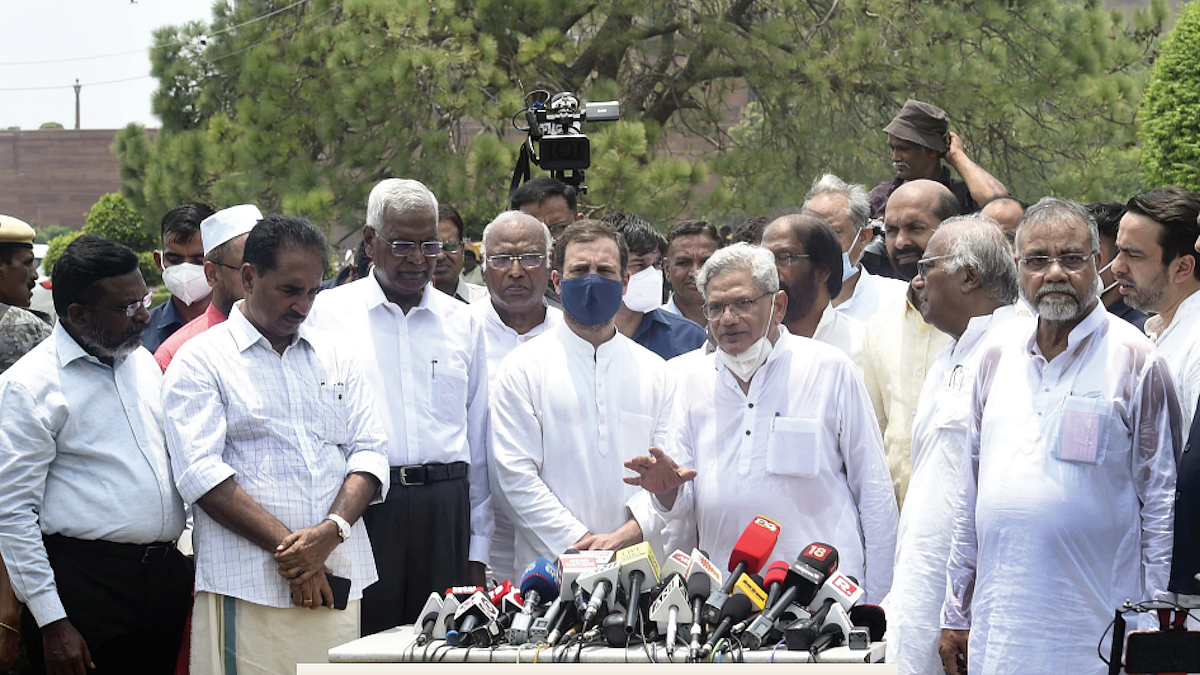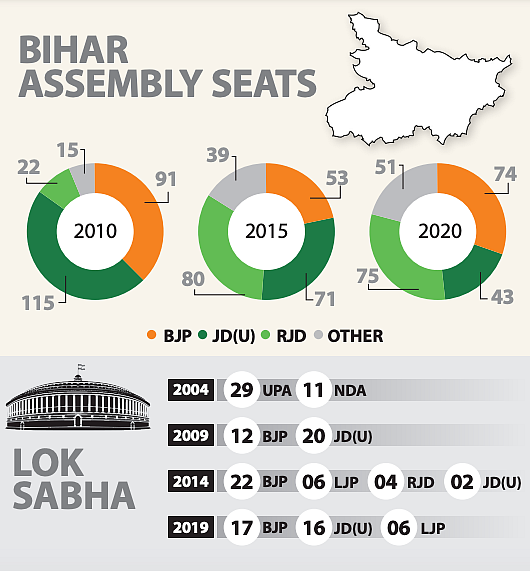Why Bihar brings new hope for the Opposition ahead of 2024
Bihar has often been the nerve centre of big change in Indian politics, and this may be another such moment, but the Opposition needs to get its act together, writes Arun Sinha

The way Nitish Kumar and Tejashwi Yadav put one past the BJP has no doubt warmed the hearts of the Opposition, and put the spring back in their step. Once again, there is a glimmer of hope that if it could be done in Bihar, then perhaps there might be a way to put it past a rampaging, marauding BJP in the 2024 Lok Sabha elections as well.
Of the fact that the JD(U)’s separation from the BJP and its reunion with the RJD alters the arithmetic for Bihar, there is no doubt. The BJP, which had been steadily gaining political space in Bihar, will be on the defensive and forced to try and defend itsrecent gains. Instead of expanding, the party will worry about retaining its seats in the assembly and the cascading effects of the recent setback in Bihar on its prospects in Lok Sabha 2024. It will also worry if Bihar will become the epicentre of more damaging shock waves in the Hindi heartland and beyond.
The prospect of contesting the Bihar assembly election on its own again might give the BJP the heebiejeebies. The last time it did so with minor allies in 2015, the mahagathbandhan -- a grand alliance of the JD(U), RJD, Congress and other parties—had blown away the mighty BJP. It had made no difference that the party throw everything it had into the battle—a battery of highimpact campaigners, led by Narendra Modi, their star of the 2014 Lok Sabha and by now the party’s trump card for most occasions.
Taken together, the results of the 2014 Lok Sabha and the 2015 state assembly demonstrated that the politically discerning Bihari voter could cast his votes differently for the Lok Sabha and the state assembly. They did not vote for Nitish in 2014 in the general election, but they overwhelmingly preferred him in 2015 in the assembly election. In their own wisdom, they decided who deserved to be the leader of the government in Delhi and who in Patna.
Losing Nitish and the thought of facing another mahagathbandhan in 2025 will certainly worry the BJP. But that is still three years away. A year before that there will be the Lok Sabha elections, and the BJP must first try and save the 17 (of 40) seats it had won here in 2019. Optimists in the party might hope for 22 seats, its 2014 tally, but it will take another dramatic turn for that to become a real possibility.
A comparison of the 2014 and 2019 Lok Sabha results in Bihar is instructive. In 2014, the BJP fought in alliance with the Lok Janshakti Party (LJP) and the Rashtriya Lok Samata Party (RLSP); the JD(U) contested in alliance with the Communist Party of India (CPI), while the RJD fought in alliance with the Congress and the Nationalist Congress Party (NCP).
In 2019, the BJP contested the election with JD(U) and the LJP. The RJD allied with the Congress, the RLSP, the Hindustani Awam MorchaSecular (HAMS) and the VikassheelInsaan Party (VSIP).
In all the 17 constituencies the BJP contested in 2019, the vote for its candidates saw a big spike compared to 2014. For instance, in Paschim Champaran, BJP candidate Sanjay Jaiswal, currently party president of the state unit, polled 3.7 lakh votes (or 43% of the votes polled) in 2014; in 2019, he polled six lakh votes (60% of the votes polled). The alliance with the JD(U) and LJP worked in its favour not just in Paschim Champaran but elsewhere too, in 2019.

But in 2024, the BJP will be back to the 2014 situation when it contested the election without the JD(U). The situation will in all likelihood be worse, because the RLSP has moved away from it and the LJP is splintered. And that could make Jaiswal’s victory very uncertain. He might have lost by nearly 30,000 votes in 2014, if he were facing a mahagathbandhan candidate. The combined vote of the JD(U), the RJD, the CPI and the CPI(ML-Liberation) in the constituency was 4.04 lakh against his 3.71 lakh. With the RLSP gone and the LJP diminished, the gap will, in all probability,widen in 2024. The party will be similarly vulnerable in several other Lok Sabha constituencies in 2024. Add to the combined vote of the mahagathbandhan, a palpable disenchantment with Modi’s governance record over the past two terms, and the prospects do not look so bright for the BJP in Bihar in 2024.
What does all this mean for national politics? Bihar has a reputation for being the nerve centre of political movements in colonial and post-colonial India, and it is perhaps showing the way again.
The BJP has been systematically going after all non-BJP governments. It has split parties by exploiting any and all vulnerabilities; it has threatened legislators with the full might of central investigative agencies; it has gobbled up state after state, even after losing the popular mandate, and in its unbridled ambition to conquer all, it has even cannibalised its own allies.
It looked like there was no stopping this marauding onslaught till Bihar, courtesy Nitish and Tejashwi, got in its way. A similar coup was in the works in Bihar too, but astute Nitish had the sense and political timing to play his trump card at just the right time.
The war, however, has just begun. One state is not enough. One political combination is not enough. One Nitish Kumar is not enough.
The BJP has fused its personality with the cult of Narendra Modi. He is the party’s EVM (electronic voting machine)—and remains strong. His popular appeal is phenomenal. He is a shrewd, relentless self-propagandist. He speaks to people in simple catchphrases every day. He is all over the mediascape—TV, print, radio, digital and social media. He has made sure that a good part of India listens only to him and he has cast a hypnotic spell on vast swathes of the country.
The battle against Modi is not simply about reclaiming votes, it is about reclaiming minds. If the minds return, the votes will too. Modi has given electoral contests a psychic dimension, and that is where the Opposition must target him. It’s not for lack of trying, but the Opposition has been misfiring.
For instance, they have attacked him for being a divisive politician. But Modi has taken the battle beyond that. Of course, Hindutva sits in the sanctum sanctorum of his political temple, but he has built three more illusory temples around it.
The temple of Nationalism. Here the deity blesses Indians with pride in a strong nation that can take care of itself and push back bullies. The second is a temple of Development. This deity creates highways, airports, industries, AIIMSes, spacecraft, 24x7 power and unicorns where there were none. The third is a temple of Welfarism. This deity gives free food, a house, a toilet, free gas cylinders, a zero-balance bank account, direct benefit transfer, health insurance and Rs 6,000 a year to every small farmer, like never before.
The Opposition has to attack the creaky foundations of these three temples he has built before they can hope to pull down the bigger temple.
They have to begin with the temple of Nationalism: they have to expose the lies in his claims to global power and glory. They have to show that he is not as strong and decisive in dealing with Pakistan and China as he projects. They have to make people understand that he whips up symbolic campaigns such as ‘Har Ghar Tiranga’ to bolster his image as the chief protector of the nation even as his policies weaken the nation.
The temple of Development is built with right-of-centre bricks. But the Opposition has not been able to attack and damage it, even though they are ideologically left-of-centre. He is an apostle of the free market. He has been giving up more and more space to the market, to crony capitalists.
The Opposition did play a role in foiling his bid to open up agriculture to the market. They are opposing his plans for disinvestment in PSUs and public sector banks. But they need to do much more to prove that his privatisation policy is totally against the interests of the people. They need to credibly explain how they will rebalance the roles of the state and the market in developing the economy and improving the lives of people.
It is in attacking his temple of Welfarism that the Opposition may find an immediate emotional connectwith the people. But they cannot do so by competing with him with more welfare schemes. Regional parties might derive electoral benefits locally, but it won’t diminish Modi’s appeal among the poor on a national scale—he seems to have run away with that constituency.
In order to pull down his temple of Welfarism, the Opposition needs to convey to the poor that he is distributing handouts to them because he has failed to provide them quality employment. That economic growth under his prime ministership is not creating stable jobs. They have to attack ‘jobless growth’— that is his Achilles heel.
The resentment of jobless youth is a fact. The participation of women in the labour force has been going down. The Opposition can build support among the youth and women by presenting to them a redesigned economic policy that will create secure jobs and incomes for them.
Is the Opposition ready with an alternative vision? Does it have a credible plan for the country’s jobless youth and women? To convince people that Modi’s slogan of ‘sabka saath, sabka vikas’ is just a slogan, they need a credible alternative plan to ensure ‘sabka vikas’.
That vision alone will also not be enough. There has to be a credible political alternative too, the kind of option that reassures people that voting in change will improve their lives. They will want to pin their hopes on a leader, a visionary figure to take on another cult figure. A fragmented opposition will give Modi a cakewalk.
(Arun Sinha is an independent jornalist and the author of ‘Nitish Kumar and the Rise of Bihar’ and ‘The Battle for Bihar’)
Follow us on: Facebook, Twitter, Google News, Instagram
Join our official telegram channel (@nationalherald) and stay updated with the latest headlines
